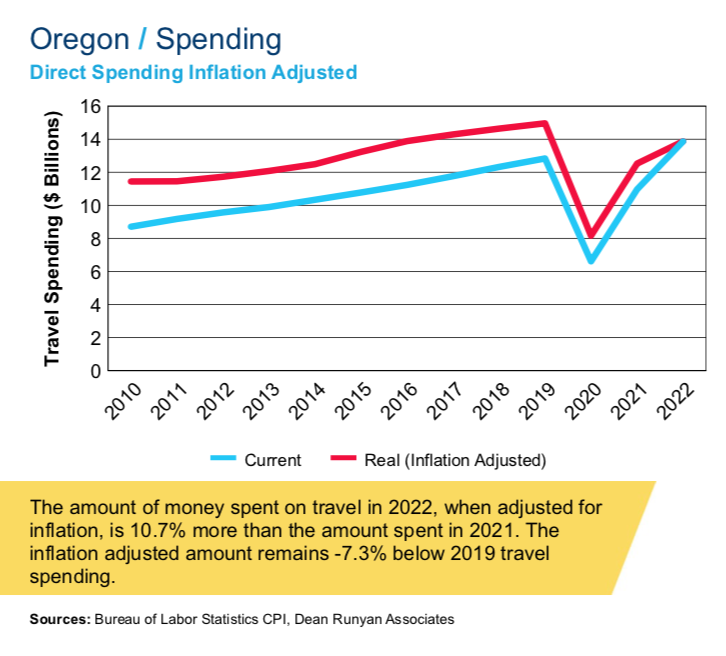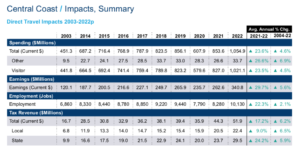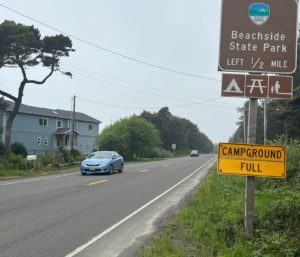
By DANA TIMS/YachatsNews
It’s taken three full years, but the number of leisure and hospitality industry jobs in Lincoln County has just edged past pre-pandemic levels.
Due to the variety of factors, however, those numbers may more or less linger exactly where they are for years to come.
That’s the view of economists, business-development specialists and hotel and restaurant owners throughout the county as the make-or-break summer tourism season gets underway.
“I don’t want to get too over the top about this, because these statistics can fluctuate month to month,” said Erik Knoder, a regional economist for the Oregon Employment Department. “But as of last month, the number of leisure and hospitality jobs in the county finally moved ahead of where they were before the pandemic hit.”
The state’s latest report shows that tourism-related employment in Lincoln County accounts for 4,760 jobs. That’s 220 more than last April and 100 more than before the pandemic closed countless restaurants and other public establishments in March 2020.
Before anyone breaks out of bottle of Champagne to celebrate, however, Knoder added a note of caution.
“The labor market is going to remain extremely tight, for a lot of reasons,” he said. “And I don’t see anything on the horizon that’s likely to change that.”

Travel by the numbers
A separate batch of statistics, compiled for Travel Oregon by a private consultant, offer additional glimmers of good news when it comes to visitor spending on the state’s central coast.

In 2022, total travel-related spending on the central coast topped $1 billion for the first time. That compares to $853 million in 2021 and $607 million in 2020. The pandemic’s impact is evident from the $856 million reported for total travel-related spending in 2019.
While visitor spending on food service dipped just more than 4 percent between 2019 and 2022, according to the Travel Oregon report, total spending on accommodations climbed by more than 80 percent over the same period.
Similarly, local tax receipts generated by visitor spending topped $22 million over that span, representing a jump of nearly 30 percent.
In a recent statement, Marcus Hinz, executive director of the Oregon Coast Visitors Association, welcomed those numbers.
“Our goal is that the tourism industry helps support and strengthen coastal communities,” he said. “Visitor spending contributes to economic development, and visitor stewardship preserves and protects coastal ecosystems and natural resources.”
Problems with staffing
With summer now in sight, hospitality-related businesses along the central coast are grappling with many of the same issues – a shortage of affordable housing to accommodate their employees; a lingering dearth of child care offerings; finding ways to pay enough in jobs that are traditionally on the lower end of the scale to attract and retain workers.

“In many ways, what we’re seeing in leisure and hospitality is something of a perfect storm,” said Paul Schuytema, executive director of the Economic Development Alliance of Lincoln County. “There are plenty of job openings, for sure. But the real challenge is finding enough people who can either afford to live here or who can afford to commute.”
Restaurants, in particular, are facing significant obstacles when it comes to getting back to full staffing levels, he said. Many have had to respond to worker shortages by curtailing hours of business or closing entirely on days when visitor loads would otherwise warrant remaining open.
“In terms of how many restaurants any particular community can support there are only so many slices of that pie,” Schuytema said. “You can probably grow the pie a bit, but if the ingredients are workers, that’s a problem.”
That message resonates with Anthony Muirhead, general manager of the Adobe Resort in Yachats. He’s been able to hire enough employees for the businesses’ 110-room hotel to match pre-pandemic levels, but there’s a shortage of cooks and wait staff to match the seven-day-a-week breakfast, lunch and dinner schedule the Adobe offered prior to the pandemic shutdown.
That same shortage is also curtailing his ability to take full advantage of the Adobe’s banquet space.
“At our current service levels, I can’t operate a restaurant and service a 100-person banquet,” Muirhead said. “The demand is certainly there, but I can’t meet demand.”
The Adobe has plans to create affordable housing options on its property to accommodate employees, but that could take a year or longer. For now, he said, he’ll have to make due with a labor shortage.
“It’s not ideal, certainly,” Muirhead said. “But we’re dealing with what we have.”

The ‘Gray Wave’ returns
At the Best Western Agate Beach in Newport, general manager Josh Conrad is seeing all sorts of trends play out when it comes to nightly visitor demand and staffing challenges.
Levels of retiree bookings – Conrad calls them the Gray Wave – are back to pre-pandemic levels, with groups from Canada and elsewhere around the country once again returning in strong numbers. And while nightly stays at his hotel remain down by about 6 percent over this time last year, overall revenue is slightly up compared to this time four years ago.
To help cope with staff shortages, Conrad has created two positions that let employees work remotely. And when it comes to banquets, he is now far more choosy in what sorts of bookings he will accept for larger groups.
“Our kitchen team serves both banquet and restaurant space,” Conrad said. “As an operator, I need to make sure that I keep good people, and one way to do that is not to push them too hard along the way.”
Those same decisions are playing out at tourism-related businesses all over the region, he said, as moves such as closing two days a week and looking to hire workers who already reside in the area are now commonplace.
“We know if we bring someone from outside our region, they won’t be able to find housing,” Conrad said. “So we are very much about finding people looking to upgrade who already live here.”
Benefits of competitive wages

Michelle Korgan, who owns Ona restaurant in Yachats, is convinced that a big part of the staffing solution involves paying her employees more than they might earn at competing establishments.
Her model, combining hourly wages, pooled tips and end-of-season bonuses paid to those who work all summer, ends up paying full-time summer employees upwards of $30 an hour. Even seasonal workers who are still in high school can make $20 an hour, she said.
That approach appears to be working, with Korgan saying that this marks the first time in her memory that Ona is going to be fully staffed for summer business, with close to 60 employees ready to go.
Korgan said she realizes that smaller restaurants face difficulties in matching that hourly pay. Yet she is equally as certain that summer tourism traffic will be bustling this year, and that opportunities to increase anyone’s bottom line will be curtailed if they can’t be open to take advantage of incoming visitors.
“June through September are the only months to make money here,” she said. “During the other months, we are just trying to cut our losses as much as possible. In the meantime, we are making lots of paychecks happen, which is very cool.”

One area that won’t be lacking for business this summer will be state campgrounds, said Dylan Anderson, who oversees state parks from Lincoln City to Yachats, including the 325 camping spots at South Beach State Park. Upwards of 2,000 people populate the site every weekend during the summer, making South Beach one of the largest “cities” in the area.
Yet a shortage of coastal housing ends up affecting seasonal employees at the site, he said. Last year, that shortage meant that fully half of the 20 seasonal staff ended up commuting daily from Willamette Valley towns such as Corvallis, Monmouth and Philomath.
State parks officials are scrambling this year to provide on-site RVs for some workers, with others looking at renting in-park housing units.
“Like everyone else, we are trying to be creative in addressing housing issues,” Anderson said.
He added that one solution being tried this year is a focus on hiring people who already live on the coast.
“And it’s exciting to have some folks who are already familiar with the area,” he said. “That gives them a lot more local knowledge when it comes to helping our overnight guests get situated.”
Takes a village
A big piece of the solution to under-staffing involves eventually building more affordable housing in Yachats and surrounding communities, said Bobbi Price, director of the Yachats Chamber of Commerce. But that takes time a lot of money, she acknowledged, meaning it is likely not going to happen anytime soon.

As an alternative, the chamber and member businesses – they have increased from the five dues-paying members when Price took over last October to the 75 currently signed up – are rolling out a campaign aimed at increasing tourism in the so-called shoulder seasons of spring and fall.
That involves trumpeting the pleasures, for instance, of autumnal storm watching or taking in the massive wintertime King Tides.
The effort during the summer, which already draw high numbers of tourists, will focus on things such as urging tourists to park their cars and walk into downtown, beach safety, tidepool etiquette, and, related messages that Price calls “educational.”
“I grew up here and still love going into town to eat at a restaurant in April, for instance, when there is no wait time at all to get a seat,” she said. “Maintaining the charm of the village here means taking all of those things into consideration.”
- Dana Tims is an Oregon freelance writer who contributes regularly to YachatsNews.com. He can be reached at DanaTims24@gmail.com



What’s the cost of tourism in terms of: increased number of traffic accidents, difficulty of first responders in responding to all calls for assistance in a timely manner (and perhaps some people/residents have to wait for assistance?) Even more road wear, when ODOT seems to have enough difficulty in maintaining U.S. Highways 101 and 20. Even more beach trash, and then there’s building fires on the beach when it’s already so dry — I’m thinking of the 3 acres that got burned by a fire built on a Lincoln City beach not long ago and how I had to repeatedly dismantle a fire ring someone had built right up against vegetation at the base of a trail down to the beach. There’d been a fire in it. I had to dismantle it three times before whoever built/was using it either finally left that beach/neighborhood (there are some short term rentals) or gave up. It’s not like there are enough coast rangers to notice and deal with all the fire building too close to vegetation. The state police have jurisdiction over the beaches, but they’re really busy in the summer too. Maybe some tourist tax dollars need to be spent on police, coast rangers hired for the summer, to deal with some of the careless/uncaring visitors before they burn some more acres? With little to no rain in May, none so far (where I live on the central coast) in June it’s already quite dry here.